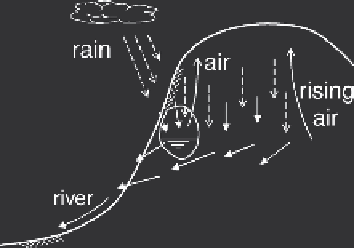Geoscience Reference
In-Depth Information
Fig. 14.3 Sketch of Aristotle's theory on the origin
of rivers. While rain percolation provides
a source of water, this is inadequate to
supply the necessary amounts. Another
important mechanism, not unlike the
generation of rain above the Earth, is the
formation of water resulting from cooling
and condensation of rising vaporous air
inside the Earth.
1996), with sinks, underground streams and caverns. Present day Greece is known to be
among the regions of the world most endowed with caves, some seven thousand of them
and of all kinds, large and small, vertical, horizontal, inland and along the coast.
14.2.2
Aristotle
It is generally agreed that Greek philosophy culminated with Aristotle (
c
. 384-322 BCE).
Even though in antiquity he was acclaimed more as a logician than as a natural philosopher,
his influence over the ensuing 18 centuries was to be so large, that it is necessary briefly to
review his ideas here.
On the origin of rivers and springs
After having described the Presocratic rainfall percolation theory in the previous quotation,
he immediately proceeds to present his own view (Aristotle, 1952, I 349 b,16).
But it is evident that if anyone tries to compute the volume of water constantly flowing each day and
then to visualize a reservoir for it, he will see that to contain the whole yearly flow of water it will have
to be as large as the earth in size or at least not so much smaller.
And though it is true that there are many such reservoirs in different parts of the earth, yet it is
absurd for anyone not to suppose that the same cause operates to turn air into water below the earth
as above it. If then cold condenses vaporous air into water above the earth, the cold beneath the earth
must be presumed to produce the same effect. So not only does water form separately within the earth
and flow from it, but the process is continuous.
Aristotle does not reject the rainfall percolation mechanism altogether; but he feels that
the available underground storage and the amount of rain are inadequate to supply the
observed river flows, so that there must be another important mechanism at work. That
mechanism is the formation of water out of vaporous air beneath the Earth's surface (see
Figure 14.3). Aristotle is correct in that water vapor does condense under the ground in
caves; they are often wet and damp and water can be seen to drip from their walls and
ceilings. It is now known, however, that the amounts produced this way are very small, and
that regular precipitation exceeds by far any kind of condensation beneath the surface as the
water supply for springs and streams. Compared to the rainfall theory of the Presocratics,
Aristotle's explanation is definitely a step backward in the development of hydrologic
theory.
Apparently, however, at this point Aristotle (1952, I 349 b,28) still does not feel that he
has presented his argument strongly or clearly enough, because he continues as follows.

